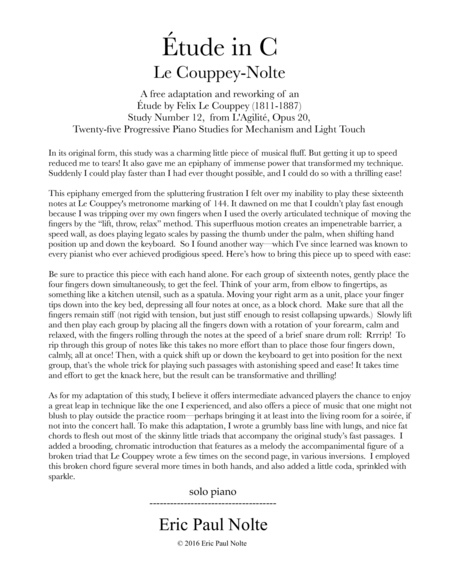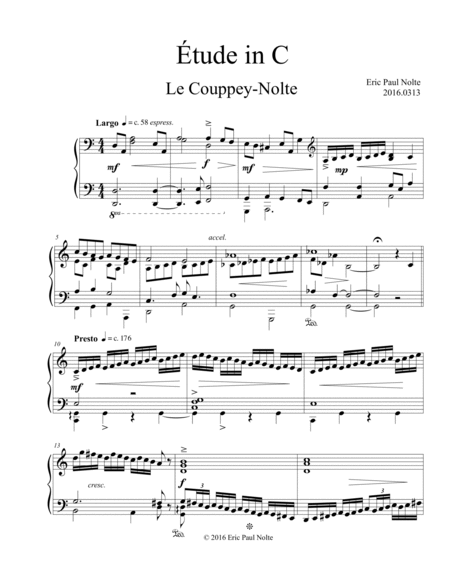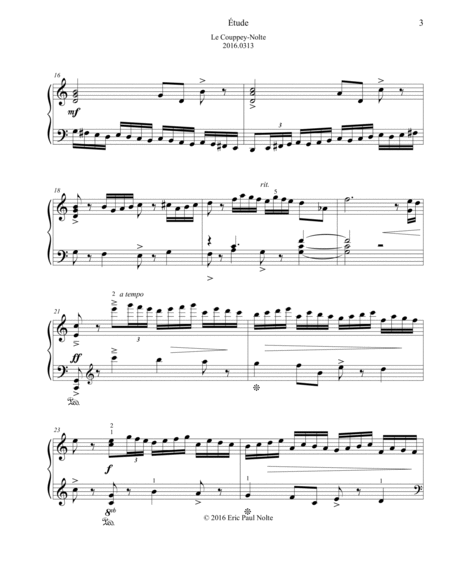Details
Description
SKU: A0.987083
Composed by Eric Paul Nolte and Felix Le Couppey. Arranged by Eric Paul Nolte. Contemporary,Instructional. Score. 5 pages. Eric Paul Nolte #1954995. Published by Eric Paul Nolte (A0.987083).This piece is a free adaptation and a complete reworking of a study by Felix Le Couppey (1811-1887), from his L'Agilité, Opus 20, 25 Progressive Studies for Mechanism and Light Touch. In its original form, this study was a charming little piece of musical fluff. But getting it up to speed reduced me to tears! It also gave me an epiphany of immense power that transformed my technique. Suddenly I could play faster than I had ever thought possible, and I could do so with a thrilling ease! This epiphany emerged from the spluttering frustration I felt over my inability to play these sixteenth notes at Le Couppey's metronome marking of 144. It dawned on me that I couldn’t play fast enough because I was tripping over my own fingers when I used the overly articulated technique of moving the fingers by the "lift, throw, relax" method. This superfluous motion creates an impenetrable barrier, a speed wall, as does playing legato scales by passing the thumb under the palm, when shifting hand position up and down the keyboard. So I found another way-which I’ve since learned was known to every pianist who ever achieved prodigious speed. Here’s how to bring this piece up to speed with ease: Be sure to practice this piece with each hand alone. For each group of sixteenth notes, gently place the four fingers down simultaneously, to get the feel. Think of your arm, from elbow to fingertips, as something like a kitchen utensil, such as a spatula. Moving your right arm as a unit, place your finger tips down into the key bed, depressing all four notes at once, as a block chord. Make sure that all the fingers remain stiff (not rigid with tension, but just stiff enough to resist collapsing upwards.) Slowly lift and then play each group by placing all the fingers down with a rotation of your forearm, calm and relaxed, with the fingers rolling through the notes at the speed of a brief snare drum roll: Rrrrip! To rip through this group of notes like this takes no more effort than to place those four fingers down, calmly, all at once! Then, with a quick shift up or down the keyboard to get into position for the next group, that’s the whole trick for playing such passages with astonishing speed and ease! It takes time and effort to get the knack here, but the result can be transformative and thrilling! As for my adaptation of this study, I believe it offers intermediate advanced players the chance to enjoy a great leap in technique like the one I experienced, and also offers a piece of music that one might not blush to play outside the practice room-perhaps bringing it at least into the living room for a soirée, if not into the concert hall. To make this adaptation, I wrote a grumbly bass line with lungs, and nice fat chords to flesh out most of the skinny little triads that accompany the original study’s fast passages. I added a brooding, chromatic introduction that features as a melody the accompanimental figure of a broken triad that Le Couppey wrote a few times on the second page, in various inversions. I employed this broken chord figure several more times in both hands, and also added a little coda, sprinkled with sparkle. Playing time is about 1 minute and 30 seconds.
This product was created by a member of ArrangeMe, Hal Leonard’s global self-publishing community of independent composers, arrangers, and songwriters. ArrangeMe allows for the publication of unique arrangements of both popular titles and original compositions from a wide variety of voices and backgrounds.
Digital Downloads are downloadable sheet music files that can be viewed directly on your computer, tablet or mobile device. Once you download your digital sheet music, you can view and print it at home, school, or anywhere you want to make music, and you don’t have to be connected to the internet. Just purchase, download and play!
PLEASE NOTE: Your Digital Download will have a watermark at the bottom of each page that will include your name, purchase date and number of copies purchased. You are only authorized to print the number of copies that you have purchased. You may not digitally distribute or print more copies than purchased for use (i.e., you may not print or digitally distribute individual copies to friends or students).




 Share
Share